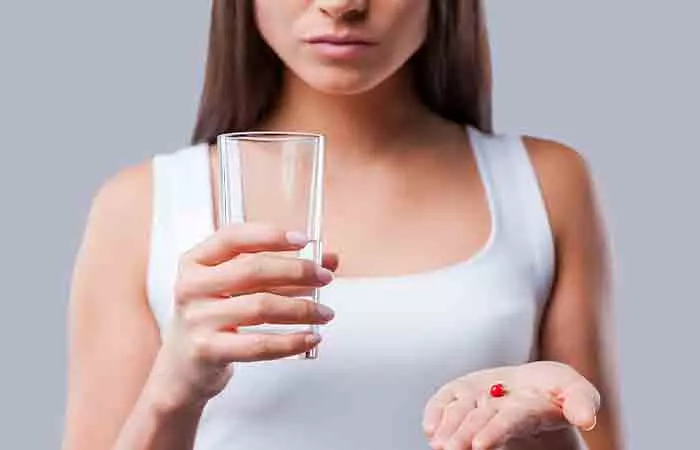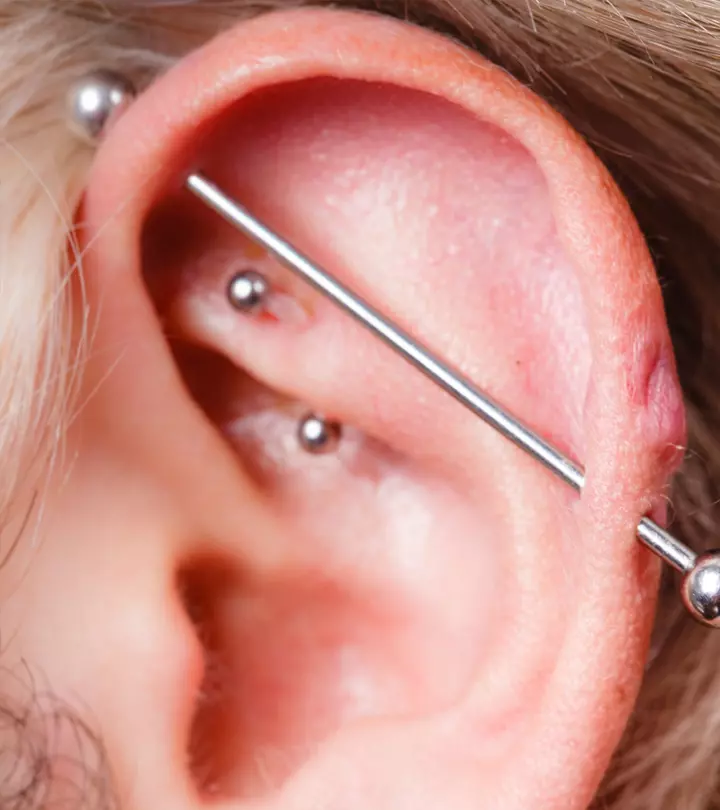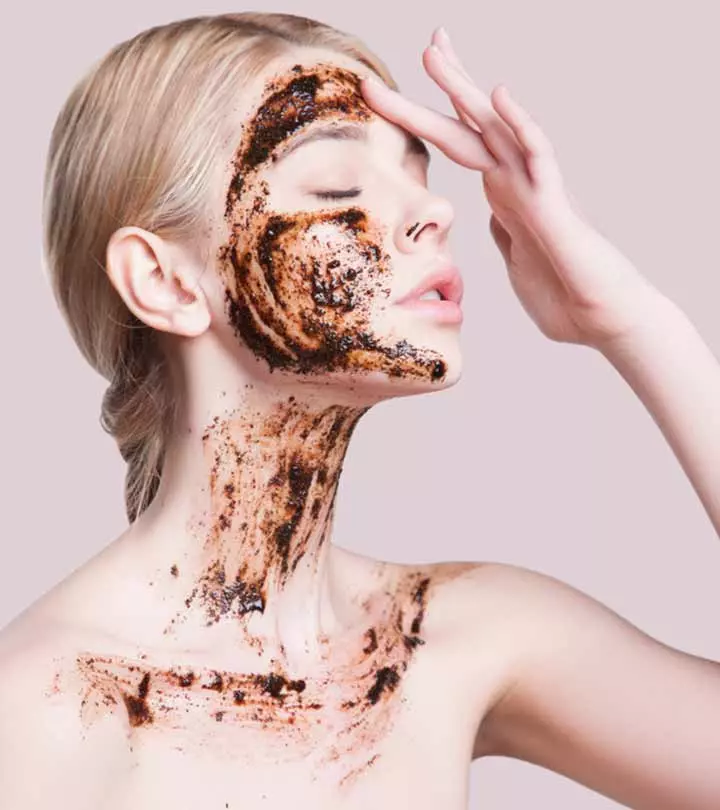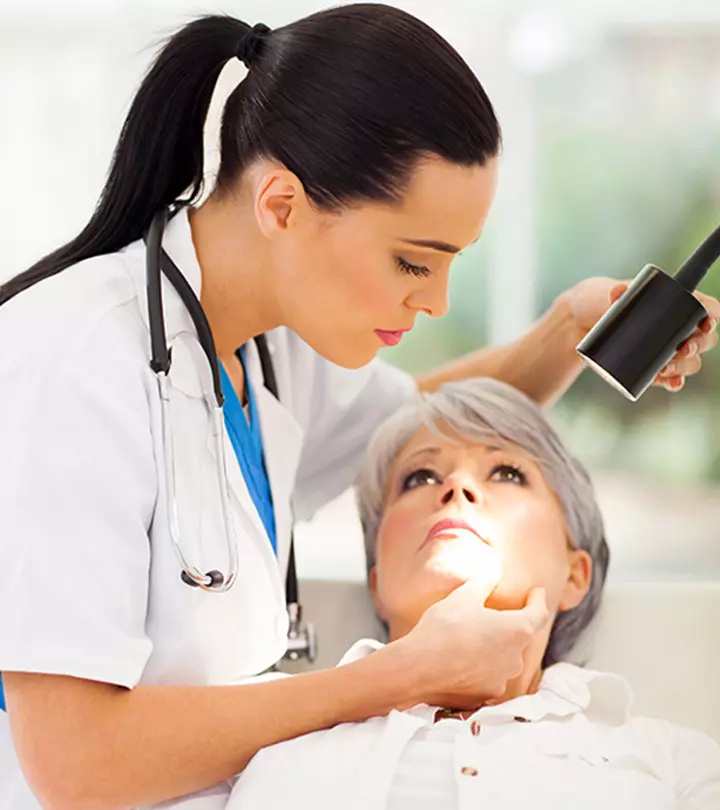Skin Abscess: Causes, Diagnosis, Treatments, And Prevention
An abscess is a big, deep boil under the skin that may look like a pimple.

Image: Shutterstock
A skin abscess or a boil looks like a pimple and is often filled with liquid, pus, and blood. It is much bigger than an average pimple and appears below the skin surface. Skin abscesses are caused by bacterial infection and may appear in the armpits, groin, and around the anus, vagina. Read on to learn the causes of a skin abscess, how to deal with it, and prevention tips.
In This Article
What Is An Abscess?
A skin abscess is similar to a pimple but only much larger and lies a lot deeper under the skin.
These are formed as a result of the defense mechanism adopted by your body to fight off infection.
A survey was conducted on 44,689 participants from 27 countries to understand the prevalence of the most common skin diseases in Europe. They found that 280 participants (0.6%) over 18 had recurrent abscesses. It was further noted that 161 (0.7%) and 119 (0.5%) males and females over 18 respectively had recurrent abscesses.
 Trivia
TriviaIn the next section let us look at what are some of the symptoms of skin abscesses.
Key Takeaways
- Skin abscesses look like pimples but sit deeper underneath the skin and may be filled with pus and blood.
- Bacterial infection on the skin is responsible for the formation of skin abscesses.
- Warm compress may work if the skin abscess is smaller than half an inch, but if it is larger, or does not seem to heal, it is better to seek medical help.
Skin Abscess Symptoms
Symptoms of skin abscess are as follows (1):
- The appearance of bumpy protrusion on the surface of the skin.
- Collection of white puss-like substance or clear fluid inside the bump.
- Painful swelling of the area around the abscess.
- Fever or chills, in case of a more severe condition.
- Warmth around the affected area.
Now having learned about the symptoms of a skin abscess, let us look at some of its causes.
What Causes A Skin Abscess?
Skin abscess is caused due to infection of the skin and its underlying tissues by disruption to the skin barrier, edemai Excess swelling or puffiness caused by too much fluid in the body’s tissue due to muscle injury, infection, or excess intake of salt. , and immune suppression.
Even healthy people without any of these conditions can develop skin abscesses due to bacterial infections. Bacterial skin abscess is mainly caused by a group of bacteria called Streptococcus pyogenes and Staphylococcus aureus (1), (2). Individuals with hidradenitis suppurativa are particularly prone to developing abscesses in sweat gland areas.
In the next section let us understand the diagnosis of skin abscesses and their possible implications.
Diagnosing An Abscess
Diagnosing a skin abscess correctly and timely is essential so that appropriate treatment can be provided to reduce the infection.
A single abscess is not a matter of concern, it can be treated at home depending on the severity.
If your abscess persists even after applying home remedies or if any of the following symptoms arise, you would need to see a doctor.
- The area around the abscess becomes red and feels warm when you touch it.
- The area around the abscess becomes swollen and painful to touch.
- Recurring abscesses are a sign of MRSA infection (Methicillin-resistant Staphylococcus aureus). This is caused due to the resistance of the bacteria to some antibiotics (3).
- You have a high fever and your pulse rate is very high.
After having diagnosed your skin abscess, your doctor will prescribe a further course of medication and the required treatment. In some cases, the skin abscess may cause a few complications, let us find out what they are in the upcoming section.
Complications Of A Skin Abscess
The most common and critical complication that arises due to skin abscess is the spread of the infection to the surrounding tissues.
In rare cases, the abscess can be fatal if it is in an area that puts pressure on vital organs. For instance, if the abscess is on the neck, it puts pressure on the trachea. The spread of the pus from the abscess can cause the surrounding tissues to die and lead to gangrene(an infection that causes flesh to rot away) (2).
Based on the severity of your abscess, appropriate medication and treatment are suggested by your doctor. The course of the medication will be discussed in the next section.
What Is The Course Of Medication For Skin Abscess?

A timely diagnosis will help in getting the right medication and treatment for your skin abscess. Antibiotics may or may not be suggested by your doctor as part of your recovery.
In a few cases, the infection may spread to deeper levels of the skin. Sometimes, the abscess recurs, and you’ll need to seek medical attention. If all goes well and your prognosis is good, you should have nothing to worry about.
In the next section let us look at how you can get rid of a skin abscess at home.
How To Get Rid Of A Skin Abscess At Home

Small skin abscesses can be treated at home and no medical assistance is required. However, you have to be careful when you are doing this. Here are a few pointers to keep in mind when you are treating your skin abscess at home.
- If your skin abscess is less than half-inch in size, you can treat it at home by applying a warm compress. Apply heat to the affected area for 30 minutes, 3-4 times a day. This may help reduce swelling and pain. It is a well-known remedy among home remedies for skin infections.
- Don’t try to drain the abscess by squeezing it. This may push the infectious material deeper into the skin.
- Do not attempt to poke the abscess with a needle or sharp object. You may end up damaging surrounding tissues and blood vessels in this process.
If home remedies don’t work on your skin abscess, it is recommended that you seek medical treatment to avoid any further complications.
If you’re wondering what medical treatment is required for dealing with a skin abscess, the next section will explain it for you.
How To Treat A Skin Abscess

The most surefire procedure to treat a skin abscess is by draining it. It is a fairly simple procedure that uses local anesthesia and a few surgical equipment.
- Your doctor first cleans the infected area with surgical spirit using a cotton swab.
- Topical anesthesia is applied to the infected area.
- An incision is made using a surgical knife to drain the pus.
- In some cases, the doctor packs the abscess with surgical gauze to drain the pus and prevent the abscess from returning.
- The doctor leaves a small portion of the gauze outside the abscess so that you can keep removing it bit-by-bit every day.
- If the cavity caused by the abscess is too large, your doctor asks you to come back and replace the gauze till the wound heals.
- After the wound heals from inside, you remove the entire gauze.
Aftercare is important to properly heal a skin abscess. Angely Mercado, a climate writer and lifestyle blogger, shares her love for running and how her affinity towards an active lifestyle worsened her recovering skin abscess on her tailbone. It had already been drained and packed with gauze but she decided to go for a walk one day only to return halfway due to the pain. “The nurse that came to change my bandages that day said that my drains and my incision were particularly bloody that day. I admitted to working out and she advised me to do as little heavy exercise as possible (i),” she recounts, drawing attention to the fact that resting is necessary for complete recovery of an abscess wound.
In some parts of China where patients refused to undergo the incision procedure, they were treated with fire needle therapy using acupuncture needles. Patients with skin abscesses less than 4cm in diameter opted for this procedure. This method is less common but can be used to address smaller hard lumps under the skin.
- The infected area is cleaned with 75% alcohol and a cotton swab.
- Sterile and disposable acupuncture needles are heated using a spirit lamp till the tip of the needle becomes red hot.
- Once the tip of the needle is red hot, it is inserted into the abscess at a 90° angle to puncture the wall of the abscess and is quickly pulled out.
- The puss is then gently squeezed out and is cleaned with a cotton swab.
- After the treatment, mupirocin ointment is applied to the area.
The patients are observed for 2 days and if the therapy is effective but pus forms again, the therapy is repeated. If the therapy is ineffective, the patients undergo B-scan ultrasonographyi A simple, non-invasive tool used to diagnose the formation of abscesses and determine the stage of infection. and are prescribed antibiotics (5 6).
 Did You Know?
Did You Know?As you know, prevention is better than cure. In the next section let us look at some quick and easy tips to prevent skin abscesses.
How To Prevent A Skin Abscess

Preventing skin abscesses completely may not be possible at all times. You can however minimize your chances of contracting the staph infection (infection caused by Staphylococcus aureus).
Follow these simple tips to minimize your risk:
- Wash your hands with soap and water as frequently as you can.
- Clean your cuts and scrapes with soap and water. Make sure you apply an antibacterial ointment to the affected area.
- Bandage your cuts and avoid exposing them to environmental factors.
- Do not share personal grooming items like razors, towels, and makeup with others.
- Regularly change and wash your bed linen. Make sure you wash it with hot water and dry it well before use.
Follow these simple tips and you may be able to prevent skin abscesses.
Have you ever wondered how a boil is different from an abscess? Have you mistaken both of them to be the same? The next section should help clear this confusion.
Abscess Vs Boil
Boils in comparison to abscesses are much smaller in size. They develop when hair follicles and the tissues surrounding them become infected. Similar to abscesses, boils are pus-filled and lie deep below the skin. They hurt a lot more than pimples and are caused by a bacterial infection.
Boils, also known as furuncle, generally go away on their own and do not cause problems. If they do not go away on their own, you need to see a doctor and get proper treatment and medication (7).
Boils, unlike abscesses, can multiply into a cluster and become a carbuncle(multiple boils formed in one spot). In some cases, boils can become abscesses. Boils are also treated the same way as abscesses; they are drained by making an incision (7).
This should help you understand the difference between boils and abscesses. If you still aren’t sure about what you have contracted, you can always seek medical advice. The next section deals with when to seek medical advice.
When To Contact A Medical Professional

When it comes to abscesses and boils, you need to contact a medical professional in the following cases.
- If your abscess is more than 1 cm in size.
- The abscess continues to grow despite home remedial treatments.
- The area around it becomes red and painful.
- You begin to notice red streaks leading away from the area. This indicates that the infection is spreading.
- If you have abscesses or boils near your neck, groin, or rectal areas (2), (3), (4), (7).
- You have high-grade fever.
The doctors will check your medical history and ask you these questions pertaining to the boil or abscess.
- How long have you had the abscess?
- Have you sustained an injury to the infected area?
- Are you on any prescription medication?
- Do you have any allergies?
Based on your medical history and recent events leading to the infection, you will receive appropriate treatment and medication.
Infographic: Simple Home Remedies For Skin Abscesses
Abscesses usually go away in 10 days, but persistent infections might cause problems. The home remedies listed in the infographic below can aid in healing abscesses. However, do a patch test to ensure you are not allergic to the ingredients. Scroll down to learn more.

Illustration: StyleCraze Design Team
A skin abscess is a large, red, painful bump filled with pus or blood that develops due to bacterial infection or inflammation. You can treat minor skin abscesses at home by applying a warm compress thrice a day till the abscess reduces. If home remedies fail to work, consult the doctor. If left untreated, skin abscesses can lead to severe complications like sepsis, a life-threatening infection that can spread throughout the body. Based on the severity of the skin abscess, they may opt for complete drainage of the abscess to avoid further infection. While you cannot prevent skin abscesses all the time, you can practice proper wound care and personal hygiene. Make sure to regularly wash and change your bed linens to minimize the risk of developing skin abscesses.
Frequently Asked Questions
How do you know when an abscess is healing?
If your abscess drains on its own and you see healthy tissues growing over the wound, these are signs your abscess is healing.
How long does an abscess take to heal?
This depends on the size of the abscess. A small abscess clears up on its own in a few days. Bigger abscesses may take between 10 to 14 days to heal.
What is the difference between a cyst and an abscess?
There are key differences between a cyst and an abscess. A cyst is a closed sac with abnormal cells and is not painful. An abscess is a warm, painful infection filled with pus.
Is saltwater good for an abscess?
Yes, salt water helps cleanse the abscess and provides relief from the pain.
Is draining an abscess painful?
No, your doctor will apply a numbing pain to avoid feeling any discomfort during the draining.
Can a skin abscess make you tired?
Yes, a skin abscess is caused by an infection. If the infection spreads to other parts of the body, it may cause fever and fatigue.
Illustration: Skin Abscess: Causes Diagnosis Treatments And Prevention

Image: Stable Diffusion/StyleCraze Design Team
Abscesses can be painful and cause swelling. Watch this informative video below to learn about the causes, symptoms, and treatments of this condition.
Personal Experience: Source
StyleCraze's articles are interwoven with authentic personal narratives that provide depth and resonance to our content. Below are the sources of the personal accounts referenced in this article.
i. Building My Body Back Up To Runhttps://medium.com/runners-life/building-my-body-back-up-to-run-2b33ecca5820
References
Articles on StyleCraze are backed by verified information from peer-reviewed and academic research papers, reputed organizations, research institutions, and medical associations to ensure accuracy and relevance. Read our editorial policy to learn more.
- Bacterial Skin Abscess
https://www.researchgate.net/publication/340798201_Bacterial_Skin_Abscess - Bacterial Skin Abscess
https://www.researchgate.net/publication/340798201_Bacterial_Skin_Abscess - Skin Infections
https://www.cdc.gov/antibiotic-use/skin-infections.html?CDC_AA_refVal=https%3A%2F%2Fwww.cdc.gov%2Fantibiotic-use%2Fcommunity%2Ffor-patients%2Fcommon-illnesses%2Fskin-infections.html - Methicillin-resistant Staphylococcus Aureus (MRSA)
https://www.cdc.gov/mrsa/about/index.html - Local Heat Increases Blood Flow and Oxygen Tension in Wounds
https://pubmed.ncbi.nlm.nih.gov/3813871/ - Effective Treatment of Small Uncomplicated Skin Abscesses with Fire Needle: A Case Series
https://pubmed.ncbi.nlm.nih.gov/34675553/ - Boils and carbuncles: Overview
https://www.ncbi.nlm.nih.gov/books/NBK513141/ - Bacterial Skin and Soft Tissue Infections in Adults: A Review of Their ‘Epidemiology’ ‘Pathogenesis’ ‘Diagnosis’ Treatment and Site of Care
https://www.ncbi.nlm.nih.gov/labs/pmc/articles/PMC2605859/
Read full bio of Dr. Swati Mutha
Read full bio of Reevan Vishwas Rego
Read full bio of Anjali Sayee
Read full bio of Swathi E



























Community Experiences
Join the conversation and become a part of our empowering community! Share your stories, experiences, and insights to connect with other beauty, lifestyle, and health enthusiasts.